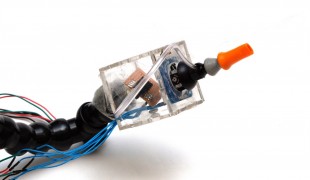- 3247
- 293
- 10
- 8
- 0
- Help Ukraine
About the solution
Like many expectant fathers, Josh Basile envisioned the day his son, Calder, would be born. However, he was aware that even the most fundamental interactions, like holding and feeding him, would be challenging. Basile, paralyzed since he was a teen, knew that most baby carriers designed for people with similar disabilities are made for those with more mobility in their upper body.
On the advice of a friend, Basile, got in touch with Johns Hopkins University’s Department of Biomedical Engineering, two months before his partner’s due date, in January 2022. His goal was to have a device that would allow him to interact with his baby face-to-face, strengthen the father-son bond, and safely transport the child on his wheelchair.
Eileen Haase, associate director of the biomedical engineering undergraduate program, launched the challenge to her students and right away 16, from biomedical and mechanical engineering, volunteered. Initially, the students were divided in teams to explore separate solutions, but in the end joined forces to create a single apparatus: a sturdy tray, made of aluminum, that would secure an infant or car seat to Basile’s wheelchair.
Days after Calder was born, Basile visited the facilities to test and learn how to use his new device. Guided by feedback from Basile, the students made some last-minute tweaks before sending the new father home to see how their invention performed in real life. It was during a neighborhood carnival that Basile fully realized how much the invention was helping him interact with his son: “I was on daddy duty. I had the baby on my chair, wheeling him all around. It gave me that independence to care for my son”.
The students were also thrilled with the device performance and impact, and shared how gratifying the experience was: “The goal was always to improve his life, and that’s what we did. It’s what makes all those hours in the machine shop worth it”.
This story was adapted from: https://www.bme.jhu.edu/news-events/news/device-makes-daddy-duty-easier-.... The images were taken from the same article.
这些解决方案不应包括使用药物,化学品或生物制品(包括食品);创伤性设备;冒犯性的,商业或内在危险的内容。该解决方案未经医学验证。请谨慎进行!如果您有任何疑问,请咨询健康专家。
DISCLAIMER: This story was written by someone who is not the author of the solution, therefore please be advised that, although it was written with the utmost respect for the innovation and the innovator, there can be some incorrect statements. If you find any errors please contact the patient Innovation team via info@patient-innovation.com
-
-
287
-
0
-
3348

Teacher Alex Truesdell is Transforming Lives: Adaptive Design Association Revolutionizes Disability Solutions
CAREGIVING
Drawing
Painting
Playing
BODY BALANCE: Maintaining body balance
(SELF)-CARE: DRINKING: Drinking independently.
(SELF)-CARE: EATING: Eating independently.
MOVING IN A WHEELCHAIR: Moving using a wheelchair.
Playing an instrument
Studying
Blindness
Hand Deformity
Neuromuscular Disorders
Assistive Daily Life Device (to help ADL)
Walking Aid (wheelchair/walker/crutches)
Restoring mobility
Replacing lost limbs
Enhancing health literacy
Promoting self-management
Promoting inclusivity and social integration
To improve Treatment/Therapy
Preventing (Vaccination, Protection, Falls, Research/Mapping)
Raise awareness
Caregiving Support
General and Family Medicine
Internal Medicine
Orthopedics
Pediatrics
Physical Medicine and Rehabilitation
United States
-
-
-
606
-
0
-
9837

Multiple sclerosis patient develops map to help people with disabilities
CAREGIVING
MOVING IN A WHEELCHAIR: Moving using a wheelchair.
WALKING WITH A WALKING AID: Walking with a walking aid
WALKING: Walking
Multiple Sclerosis
Website
App (Including when connected with wearable)
Restoring mobility
Enhancing health literacy
Promoting self-management
Rehabilitating After Stroke
Managing Neurological Disorders
Building Supportive Community Relationships
Promoting inclusivity and social integration
Recovering from Traumatic Injuries
Enhancing Mental Health
Raise awareness
Caregiving Support
General and Family Medicine
Internal Medicine
Neurology
Neurosurgery
Physical Medicine and Rehabilitation
United States
-
-
-
303
-
0
-
3999

Puffin innovations- How a Patient is improving wheelchair puff and sip functionalities to all users
CAREGIVING
MOVING IN A WHEELCHAIR: Moving using a wheelchair.
Cerebral Palsy
Assistive Technology access
Muscle cramps or spasms
Paralysis of the legs and lower body
Muscle weakness
Loss of balance
Numbness or tingling in the extremities
Mood swings
Restoring mobility
Enhancing health literacy
Promoting self-management
Manage Medication
Managing Neurological Disorders
To improve Treatment/Therapy
Preventing (Vaccination, Protection, Falls, Research/Mapping)
Raise awareness
Caregiving Support
General and Family Medicine
Neurology
Mobility issues
United States
-
 zh
zh